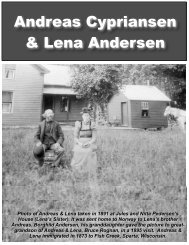Viking Heraldy of Lewis & Cinda - Bruce Rognan
Viking Heraldy of Lewis & Cinda - Bruce Rognan
Viking Heraldy of Lewis & Cinda - Bruce Rognan
You also want an ePaper? Increase the reach of your titles
YUMPU automatically turns print PDFs into web optimized ePapers that Google loves.
unusually early age. After his mother told him that he was actually the son <strong>of</strong> the former Norwegian king Sigurd<br />
II, however, he left for Norway (1174) to claim the throne. By 1177 he had become leader <strong>of</strong> the Birch Legs, rivals<br />
<strong>of</strong> the incumbent ruler Magnus V. A skillful military leader, Sverre was proclaimed king in the Trondheim<br />
region and soundly defeated the forces <strong>of</strong> Magnus in 1179. He became sole king <strong>of</strong> Norway in 1184 after his<br />
troops defeated and killed Magnus.<br />
Sverre made peace with the exiled archbishop Eystein Erlendsson, a supporter <strong>of</strong> Magnus V, after Eystein's<br />
return to Norway in 1183. Sverre's assertion <strong>of</strong> royal power to elect bishops and his demand for a reduction in<br />
the archbishop's personal armed forces, however, the archbishop refused to crown Sverre and fled to Denmark<br />
with many <strong>of</strong> the nation's bishops in 1190. The remaining bishops crowned Sverre in 1194 but were later excommunicated<br />
along with the king by Pope Innocent III.<br />
The stealing <strong>of</strong> viking trade by the Hanseatic League <strong>of</strong> German merchants demands had a major bearing upon<br />
the decline <strong>of</strong> the <strong>Viking</strong> states.These foreign merchants utterly demolished the phenomenally successful viking<br />
trade that had for so long nourished and sustained the distant settlements <strong>of</strong> the viking peoples. Up until the<br />
Hansa, no one was better at trade and piracy than the Norwegian <strong>Viking</strong>s. Gradually the Hansa replaced Norway<br />
and they became better pirates, as well as better traders, and as a result, Norway lost its power. Norway’s<br />
decline in strength from the rise <strong>of</strong> the Hanseatic League began to occur in Sverre’s rule, but it was unforeseen<br />
how much problem this woul cause later. Within a hundred years <strong>of</strong> Sverre's death the Hansa had unmistakably<br />
become the major power in the land,<br />
Hakon III Sverreson (1180- 1204)<br />
Hakon became King in 1202 when his father died. Sverre and his son Håkon were leaders <strong>of</strong> the Birkebeiner<br />
(Birch Legs) party. Håkon is first mentioned as one <strong>of</strong> the leaders <strong>of</strong> his father's armies in a battle against the<br />
Bagler in Oslo in 1197. Subsequently he is mentioned several times as taking part in his father's wars against<br />
the Bagler. On his deathbed his father, wrote a letter to Håkon advising him to settle the longstanding dispute<br />
with the church. When the news <strong>of</strong> Sverre's death reached Håkon and the Birkebeiner assembled in Nidaros,<br />
Håkon was first taken as chieftain by the Birkebeiner. The same spring he was taken as king at the thing in Nidaros.<br />
The same spring the Norwegian bishops, who had been in exile in Sweden and Denmark and had supported<br />
the Bagler, returned to Norway and made a settlement with Håkon. Håkon is said to have been on friendly<br />
terms with the farmers and the common people, and the Bagler party soon lost much <strong>of</strong> its support. In the<br />
autumn <strong>of</strong> 1202, the Bagler king Inge Magnusson was killed by the local farmers <strong>of</strong> Oppland and the Bagler<br />
party in Norway was dissolved. Håkon appears to have had a troubled relationship with his father's queen,<br />
Margareta Eriksdotter. After Sverre's death, Margareta attempted to return to her native Sweden with her<br />
daughter by Sverre, Kristina. Håkon's men forcibly separated her from her daughter, as he wanted to keep her<br />
at his court. Subsequently, Margareta seemingly settled with Håkon and went to his court. During Christmas in<br />
1203, Håkon fell ill after a bloodletting, and on 1 January 1204 he died. His death was suspected as poisoning<br />
and his step-mother Margareta was suspected <strong>of</strong> the crime. Inga <strong>of</strong> Varteig, whom Håkon had taken as a concubine<br />
for a time in 1203, appeared at the Birkebeiner court with Håkon's son. The child had been born in<br />
present-day Østfold after the death <strong>of</strong> the putative father. The boy, named Håkon after his father, later became<br />
king Håkon IV in the summer <strong>of</strong> 1218.<br />
During Håkon's brief reign, he managed to release Norway from the church's interdict, and end the civil wars, at<br />
least for a time. His early death sparked a renewal <strong>of</strong> the fighting, however, despite some <strong>of</strong> the problems during<br />
the cicil war, Hakon’s reign is considered the beginning <strong>of</strong> the "golden age" (1217-1319) in medieval Norwegian<br />
history. Hakon’s treaty with Henry III <strong>of</strong> England in 1217 was the earliest commercial treaty known in either<br />
nation, but it was shortlived.<br />
Hakon IV Hakonsson (1204- 1263)<br />
King Hakon IV was born: 1204 in Falkenborg, Eidsberg, Østfold, Norway. He married:<br />
1) Kanga (no children)<br />
2) Margrete Skulesdatter on 25 May 1225<br />
Hakon IV is acknowledged as the illegitimate posthumous son <strong>of</strong> Haakon III. Haakon was reared at the court <strong>of</strong><br />
Inge II and, on Inge's death in 1217, was proclaimed king by the Birchlegs, the adherents <strong>of</strong> Sverre. Doubts <strong>of</strong><br />
his paternity, especially by the ecclesiastical leaders, were allayed after his mother passed through an ordeal <strong>of</strong><br />
hot irons (1218). The early years <strong>of</strong> his reign were disturbed by uprisings in the eastern region <strong>of</strong> the country by



